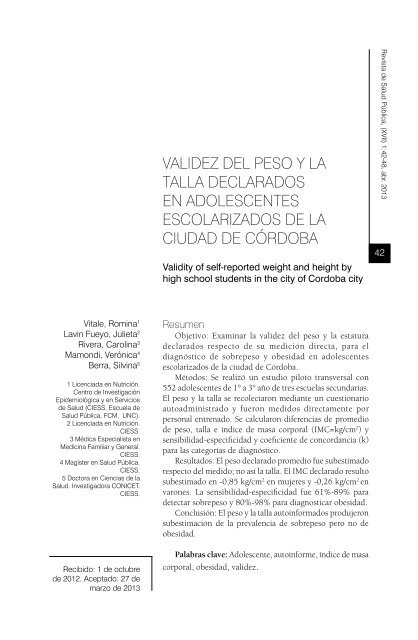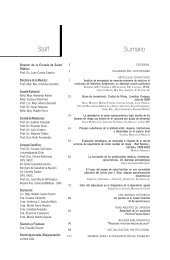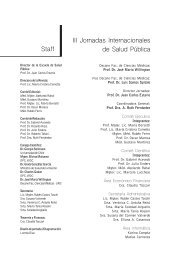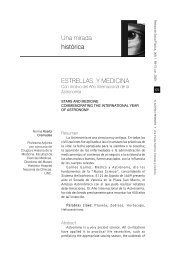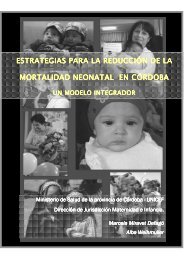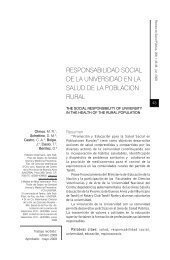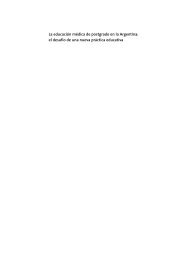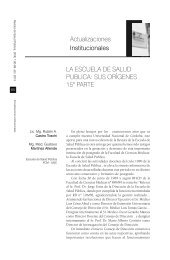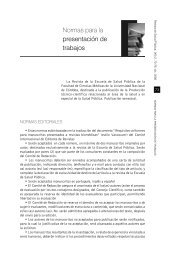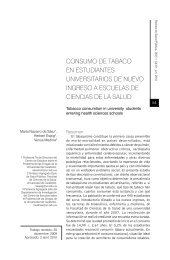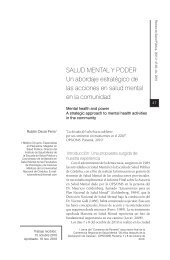validez del peso y la talla declarados en adolescentes ...
validez del peso y la talla declarados en adolescentes ...
validez del peso y la talla declarados en adolescentes ...
- No tags were found...
Create successful ePaper yourself
Turn your PDF publications into a flip-book with our unique Google optimized e-Paper software.
VALIDEZ DEL PESO Y LATALLA DECLARADOSEN ADOLESCENTESESCOLARIZADOS DE LACIUDAD DE CÓRDOBAValidity of self-reported weight and height byhigh school stud<strong>en</strong>ts in the city of Cordoba cityRevista de Salud Pública, (XVII) 1:42-48, abr. 201342Vitale, Romina 1Lavin Fueyo, Julieta 2Rivera, Carolina 3Mamondi, Verónica 4Berra, Silvina 51 Lic<strong>en</strong>ciada <strong>en</strong> Nutrición.C<strong>en</strong>tro de InvestigaciónEpidemiológica y <strong>en</strong> Serviciosde Salud (CIESS, Escue<strong>la</strong> deSalud Pública, FCM, UNC).2 Lic<strong>en</strong>ciada <strong>en</strong> Nutrición.CIESS.3 Médica Especialista <strong>en</strong>Medicina Familiar y G<strong>en</strong>eral.CIESS.4 Magíster <strong>en</strong> Salud Pública.CIESS.5 Doctora <strong>en</strong> Ci<strong>en</strong>cias de <strong>la</strong>Salud. Investigadora CONICET.CIESS.Recibido: 1 de octubrede 2012. Aceptado: 27 demarzo de 2013Resum<strong>en</strong>Objetivo: Examinar <strong>la</strong> <strong>validez</strong> <strong>del</strong> <strong>peso</strong> y <strong>la</strong> estaturadec<strong>la</strong>rados respecto de su medición directa, para eldiagnóstico de sobre<strong>peso</strong> y obesidad <strong>en</strong> adolesc<strong>en</strong>tesesco<strong>la</strong>rizados de <strong>la</strong> ciudad de Córdoba.Métodos: Se realizó un estudio piloto transversal con552 adolesc<strong>en</strong>tes de 1° a 3° año de tres escue<strong>la</strong>s secundarias.El <strong>peso</strong> y <strong>la</strong> tal<strong>la</strong> se recolectaron mediante un cuestionarioautoadministrado y fueron medidos directam<strong>en</strong>te porpersonal <strong>en</strong>tr<strong>en</strong>ado. Se calcu<strong>la</strong>ron difer<strong>en</strong>cias de promediode <strong>peso</strong>, tal<strong>la</strong> e índice de masa corporal (IMC=kg/cm 2 ) ys<strong>en</strong>sibilidad-especificidad y coefici<strong>en</strong>te de concordancia (k)para <strong>la</strong>s categorías de diagnóstico.Resultados: El <strong>peso</strong> dec<strong>la</strong>rado promedio fue subestimadorespecto <strong>del</strong> medido; no así <strong>la</strong> tal<strong>la</strong>. El IMC dec<strong>la</strong>rado resultósubestimado <strong>en</strong> -0,85 kg/cm 2 <strong>en</strong> mujeres y -0,26 kg/cm 2 <strong>en</strong>varones. La s<strong>en</strong>sibilidad-especificidad fue 61%-89% paradetectar sobre<strong>peso</strong> y 80%-98% para diagnosticar obesidad.Conclusión: El <strong>peso</strong> y <strong>la</strong> tal<strong>la</strong> autoinformados produjeronsubestimación de <strong>la</strong> preval<strong>en</strong>cia de sobre<strong>peso</strong> pero no deobesidad.Pa<strong>la</strong>bras c<strong>la</strong>ve: Adolesc<strong>en</strong>te, autoinforme, índice de masacorporal, obesidad, <strong>validez</strong>.
AbstractObjective: To examine the validity of self-reported weight and height versus their directmeasurem<strong>en</strong>t for the diagnosis of overweight and obesity in adolesc<strong>en</strong>t stud<strong>en</strong>ts in thecity of Cordoba.Methods: A cross-sectional pilot study was carried out with 552 adolesc<strong>en</strong>ts att<strong>en</strong>ding1st to 3rd year at three high schools. Weight and height were collected through a selfadministeredquestionnaire and were measured directly by trained staff. We calcu<strong>la</strong>tedaverage differ<strong>en</strong>ces for weight, height and body mass index (BMI = kg/cm2), and s<strong>en</strong>sitivityspecificityand concordance coeffici<strong>en</strong>t (k) were analyzed for overweight and obesitydiagnosis.Results: Average self-reported weight was underestimated compared to measuredweight, but not self-reported height. Dec<strong>la</strong>red BMI was underestimated -0.85 kg/cm2in wom<strong>en</strong> and -0.26 kg/cm2 in m<strong>en</strong>. The s<strong>en</strong>sitivity-specificity was 61%-89% to detectoverweight, and 80%-98% to diagnose obesity.Conclusion: The self-reported weight and height underestimated the preval<strong>en</strong>ce ofoverweight but not of obesity.Key words: adolesc<strong>en</strong>t, self report, body mass index, obesity, validity.IntroducciónEn <strong>la</strong> actualidad, el sobre<strong>peso</strong> y <strong>la</strong> obesidad son considerados problemas importantes desalud pública. Su preval<strong>en</strong>cia ha aum<strong>en</strong>tado <strong>en</strong> los últimos años <strong>en</strong> todo el mundo, incluso<strong>en</strong> niños y <strong>en</strong> adolesc<strong>en</strong>tes, y está afectando progresivam<strong>en</strong>te a muchos países de bajos ymedianos ingresos, sobre todo <strong>en</strong> el medio urbano. En el <strong>la</strong>rgo p<strong>la</strong>zo, <strong>la</strong> obesidad infantiles un predictor de obesidad <strong>en</strong> <strong>la</strong> adultez, es por ello que resulta fundam<strong>en</strong>tal establecerun monitoreo continuo <strong>del</strong> estado nutricional de <strong>la</strong> pob<strong>la</strong>ción. 1El <strong>peso</strong> y <strong>la</strong> estatura son dos de <strong>la</strong>s medidas antropométricas utilizadas con mayorfrecu<strong>en</strong>cia <strong>en</strong> el campo clínico y epidemiológico. La medición de ambas variables puedeemplearse para realizar una vigi<strong>la</strong>ncia de <strong>la</strong> salud y <strong>del</strong> estado nutricional, evaluar <strong>la</strong> eficaciade los tratami<strong>en</strong>tos para diversos padecimi<strong>en</strong>tos y determinar el riesgo de <strong>la</strong> pob<strong>la</strong>ciónpara ciertos trastornos. El índice de masa corporal (IMC) es un indicador global <strong>del</strong>estado antropométrico calcu<strong>la</strong>do a partir <strong>del</strong> <strong>peso</strong> y <strong>la</strong> tal<strong>la</strong>. Los estudios epidemiológicosde gran esca<strong>la</strong> que buscan conocer <strong>la</strong> preval<strong>en</strong>cia de obesidad <strong>en</strong> niños y adolesc<strong>en</strong>tes,utilizan frecu<strong>en</strong>tem<strong>en</strong>te el IMC. Las mediciones directas de <strong>peso</strong> y tal<strong>la</strong> pres<strong>en</strong>tan ciertaslimitaciones: aum<strong>en</strong>to <strong>del</strong> costo <strong>del</strong> trabajo de campo, dificultades para tras<strong>la</strong>dar losinstrum<strong>en</strong>tos de medición y <strong>la</strong> capacitación de los evaluadores. T<strong>en</strong>i<strong>en</strong>do <strong>en</strong> cu<strong>en</strong>ta estasdificultades varios estudios epidemiológicos han utilizado ambas mediciones de maneraautoinformada. 23-4Cuando se utiliza este tipo de información <strong>en</strong> estudios epidemiológicos, es necesarioasegurar su <strong>validez</strong> y confiabilidad. Se debe tomar <strong>en</strong> cu<strong>en</strong>ta <strong>la</strong> magnitud de una posibledifer<strong>en</strong>cia al recurrir al autoinforme de <strong>la</strong> pob<strong>la</strong>ción. 5Aunque <strong>la</strong> mayoría de los estudios sobre el <strong>peso</strong> y <strong>la</strong> tal<strong>la</strong> dec<strong>la</strong>rados se han realizado<strong>en</strong> adultos, exist<strong>en</strong> datos de que <strong>la</strong> percepción subjetiva de los adolesc<strong>en</strong>tes muestra unaalta corre<strong>la</strong>ción con los datos de mediciones directas. Sin embargo, aunque <strong>la</strong> fiabilidadde este método puede ser alta, su <strong>validez</strong> aún es incierta. 6La <strong>validez</strong> de <strong>la</strong>s medidas auto informadas de <strong>peso</strong> y tal<strong>la</strong> <strong>en</strong> adolesc<strong>en</strong>tes parece estarinflu<strong>en</strong>ciada por <strong>la</strong> edad, el sexo y el estado nutricional; con una t<strong>en</strong>d<strong>en</strong>cia a sobreestimar<strong>la</strong> tal<strong>la</strong> y subestimar el <strong>peso</strong> sobre todo <strong>en</strong> adolesc<strong>en</strong>tes obesos. Además, estudiosprevios muestran también difer<strong>en</strong>cias según el género, ya que <strong>la</strong> altura suele resultar mássobreestimada <strong>en</strong> varones y el <strong>peso</strong> más subestimado <strong>en</strong> <strong>la</strong>s mujeres; esto deriva finalm<strong>en</strong>te<strong>en</strong> un subregistro de <strong>la</strong> preval<strong>en</strong>cia <strong>del</strong> sobre<strong>peso</strong> y <strong>la</strong> obesidad. 67891011-12Revista de Salud Pública, (XVII) 1:42-48, abr. 2013 Vitale R, Lavin Fueyo J, Rivera C, Mamondi V, Berra S. | Validez <strong>del</strong> <strong>peso</strong> y <strong>la</strong> tal<strong>la</strong> dec<strong>la</strong>rados <strong>en</strong> adolesc<strong>en</strong>tes...43
qui<strong>en</strong>es por voluntad propia desistieron su participación (11). La edad promedio fue 13,5años (DE=1,3), compr<strong>en</strong>dida <strong>en</strong>tre 11 y 18 años; 52% eran varones (tab<strong>la</strong> 1).Tab<strong>la</strong> 1. Características de <strong>la</strong> pob<strong>la</strong>ción <strong>en</strong> estudion %Total 552 100%SexoHombresMujeresEdad11-14 años15-18 años28726544011252%48%80%20%El <strong>peso</strong> dec<strong>la</strong>rado fue m<strong>en</strong>or que el medido directam<strong>en</strong>te <strong>en</strong> mujeres (difer<strong>en</strong>ciapromedio=-1,50 kg; p
Revista de Salud Pública, (XVII) 1:42-48, abr. 2013 Vitale R, Lavin Fueyo J, Rivera C, Mamondi V, Berra S. | Validez <strong>del</strong> <strong>peso</strong> y <strong>la</strong> tal<strong>la</strong> dec<strong>la</strong>rados <strong>en</strong> adolesc<strong>en</strong>tes...48- findings from three popu<strong>la</strong>tion surveys in Ire<strong>la</strong>nd. BMC Public Health. 2010; 10: 560.3. Del Duca G, González-Chica D, Santos J, Knuth A, Camargo M, Araújo C. Selfreportedweight and height for determining nutritional status of adults and elderly: validityand implications for data analysis. Cad. Saúde Pública. 2012; 28(1): 75-85.4. Cole T.J, Bellizzi M.C, Flegal K.M, Dietz W.H. Establishing a standarddefinition for child overweight and obesity worldwide: international survey. BritishMedical Journal. 2000; Vol. 320.5. Unikel-Santoncini C, Ocampo-Ortega R, Zambrano-Ruiz J. Exactitud <strong>del</strong> autorreportede <strong>peso</strong> y tal<strong>la</strong> <strong>en</strong> mujeres de 15 a 19 años <strong>del</strong> Estado de México. Salud Pública Méx 2009;51(3):194-201.6. Himes JH, Hannan P, Wall M, Neumark-Sztainer D. Factors associated with errorsin self-reports of stature, weight, and Body Mass Index in Minnesota adolesc<strong>en</strong>ts. AnnEpidemiol 2005; 15:272-8.7. Br<strong>en</strong>er ND , Mcmanus T , DA Galuska , Lowry R , H Wechsler . Reliability and validityof self-reported height and weight among high school stud<strong>en</strong>ts. J Adolesc Health 2003;32 (4):281-7.8. Romanzini M, Reichert F, Ronque E, Lopes A, Petroski E. Determinação do estadonutricional de adolesc<strong>en</strong>tes por meio de medidas referidas de <strong>peso</strong> e estatura: um estudode validaçã. Rev. bras. ativ. fís. saúde 2011;16(1):31-36.9. De Vri<strong>en</strong>dt T, Huybrechts I, Ottevaere C, Van Trimpont I, De H<strong>en</strong>auw S. Validity ofSelf-Reported Weight and Height of Adolesc<strong>en</strong>ts, Its Impact on C<strong>la</strong>ssification into BMI-Categories and the Association with Weighing Behaviour. Int. J. Environ. Res. Public Health2009; 6(10): 2696-2711.10. Enes C, Fernandez P, Fúncia M, Voci S, Toral N, Romero A, S<strong>la</strong>ter B. Validity andreliability of self-reported weight and height measures for the diagnoses of adolesc<strong>en</strong>t’snutritional status. Rev. bras. epidemiol. 2009;12(4): 627-635.11. Jans<strong>en</strong> W, van de Looij-Jans<strong>en</strong> PM, Ferreira I, de Wilde EJ, Brug J: Differ<strong>en</strong>ces inmeasured and self-reported height and weight in Dutch adolesc<strong>en</strong>ts. Ann Nutr Metab2006; 50:339-346.12. Brettschneider AK, Schaffrath Rosario A, Ellert U. Validity and predictors of BMIderived from self-reported height and weight among 11- to 17-year-old German adolesc<strong>en</strong>tsfrom the KiGGS study. BMC Res Notes. 2011; 4: 414.13. Currie C, Roberts C, Morgan A, Smith R, Settertobulte W, Samdal O, Barnekow V.Young people health in context. Health Behavior in School-aged Childr<strong>en</strong> (HBSC) study:international report from the 2001/2002 survey. Health Policy for Childr<strong>en</strong> and Adolesc<strong>en</strong>t,No. 4; 2004. World Health Organization, Europe.14. Ottova V, Erhart M, Rajmil L, Dett<strong>en</strong>born-Betz L, Rav<strong>en</strong>s-Sieberer U. Overweightand its impact on the health-re<strong>la</strong>ted quality of life in childr<strong>en</strong> and adolesc<strong>en</strong>ts: results fromthe European KIDSCREEN survey. Qual Life Res. 2012 Feb;21(1):59-69.15. Berra S, Bustingorry V, H<strong>en</strong>ze C, Díaz MP, Rajmil L, Butinof M. Adaptacióntranscultural <strong>del</strong> cuestionario KIDSCREEN para medir <strong>la</strong> calidad de vida re<strong>la</strong>cionada con<strong>la</strong> salud <strong>en</strong> pob<strong>la</strong>ción arg<strong>en</strong>tina de 8 a 18 años. Arch Arg<strong>en</strong>t Pediatr 2009; 107(4):307-314.16. Altman, D.G. Practical Statistics for Medical Research; Chapman & Hall: London,UK, 1991; 403-409.17. Sherry B, Jefferds ME, Grummer-Strawn L. Accuracy of Adolesc<strong>en</strong>t Self-reportof Height and Weight in Assessing Overweight Status. A Literature Review. Arch PediatrAdolesc Med. 2007; 161(12):1154-1161.18. Ros<strong>en</strong>blum GD, Lewis M. The re<strong>la</strong>tions among body image, phisycal attractiv<strong>en</strong>ess,and body mass in adolesc<strong>en</strong>ce. Child Dev 1999; 70: 50-64.19. Enes C, Pegolo G, Silva M. Medidas autorreferidas versus medidas aferidas de <strong>peso</strong>e altura de adolesc<strong>en</strong>tes resid<strong>en</strong>tes em áreas rurais de Piedade, São Paulo. Nutrire Rev. Soc.Bras. Alim<strong>en</strong>t. Nutr 2009; 34(2): 59-70.


